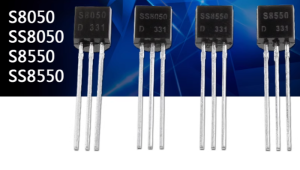Introduction to the S8050 PNP Transistor
The S8050 is a widely used PNP transistor encapsulated in a TO-92 package. Known for its versatility and reliability, the S8050 is suitable for a variety of electronic applications, including switching and amplification. This article will explore the key features, setup, common applications, troubleshooting tips, and benefits of using the S8050 PNP transistor in your projects.

Key Features of the S8050 PNP Transistor
The S8050 transistor offers several features that make it suitable for a wide range of applications:
- Type: PNP transistor
- Package: TO-92, a popular package for through-hole components
- Collector-Emitter Voltage (Vce): -40V
- Collector Current (Ic): -500mA
- Power Dissipation (Ptot): 625mW
- DC Current Gain (hFE): 100 to 300
- Low Saturation Voltage: Ensures efficient operation in switching applications
Setting Up the S8050 PNP Transistor
Setting up the S8050 PNP transistor in your circuit involves understanding its pin configuration and the basic principles of PNP transistor operation. Here’s a step-by-step guide:
- Pin Configuration: The TO-92 package has three pins: the emitter (E), base (B), and collector (C). When looking at the flat side of the transistor with the leads facing down, the pinout from left to right is usually E-B-C.
- Biasing the Transistor: For the PNP transistor to operate correctly, the base must be more negative than the emitter, and the collector must be more negative than the base.
- Connecting the Load: Connect your load between the collector and the positive supply voltage (Vcc).
- Base Resistor: Use a base resistor to limit the current flowing into the base. The value of the resistor can be calculated based on the required base current and the supply voltage.
Common Applications of the S8050 PNP Transistor
The S8050 is widely used in various applications due to its reliability and performance. Some common applications include:
- Switching: Used to control the flow of current in circuits, turning devices on and off.
- Amplification: Used in amplifier circuits to boost signal strength.
- LED Drivers: Control the current flowing through LEDs, providing consistent brightness.
- Motor Drivers: Drive small motors in robotics and other electronic projects.
- Signal Modulation: Used in modulation circuits for communication systems.
Troubleshooting Common Issues
When working with the S8050 PNP transistor, you may encounter some common issues. Here are a few troubleshooting tips:
- No Current Flow: Ensure the base-emitter junction is properly biased (base is more negative than the emitter). Check all connections and ensure the transistor is not damaged.
- Excessive Heat: Verify that the current through the transistor does not exceed its maximum ratings. Use a heat sink if necessary to dissipate heat.
- Incorrect Operation: Ensure the transistor is not saturated or cut-off. Adjust the base resistor value to provide the appropriate base current.
- Signal Distortion: Check for proper biasing and ensure that the transistor is operating in the correct region (active region for amplification).
Benefits of Using the S8050 PNP Transistor
The S8050 offers several advantages for electronics enthusiasts and professionals alike:
- Versatility: Suitable for a wide range of applications, from switching to amplification.
- Cost-Effective: The S8050 is an affordable solution for many electronic projects.
- Reliable Performance: Known for its stability and consistent performance across various conditions.
- Ease of Use: Simple to implement in circuits with minimal external components required.
- Availability: Widely available and supported, making it easy to source and find documentation or support.
Conclusion
The S8050 PNP transistor in a TO-92 package is a versatile and reliable component for a wide range of electronic applications. Its ease of use, low cost, and high performance make it an excellent choice for both beginners and experienced engineers. By following this guide, you can effectively utilize the S8050 in your projects.
Click here to make an enquiry or purchase.
FAQ
Q1: What is the maximum collector-emitter voltage for the S8050? A1: The maximum collector-emitter voltage (Vce) for the S8050 is -40V.
Q2: How much current can the S8050 handle? A2: The S8050 can handle a maximum collector current (Ic) of -500mA.
Q3: Can the S8050 be used for amplification purposes? A3: Yes, the S8050 is commonly used in amplifier circuits to boost signal strength.
Q4: What is the typical DC current gain of the S8050? A4: The typical DC current gain (hFE) of the S8050 ranges from 100 to 300.
Q5: Do I need a heat sink for the S8050? A5: A heat sink is recommended if your application involves high currents that could cause the transistor to overheat.
